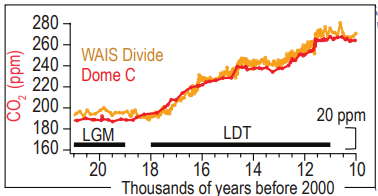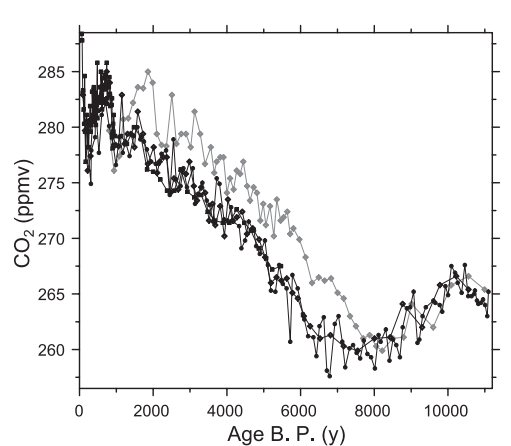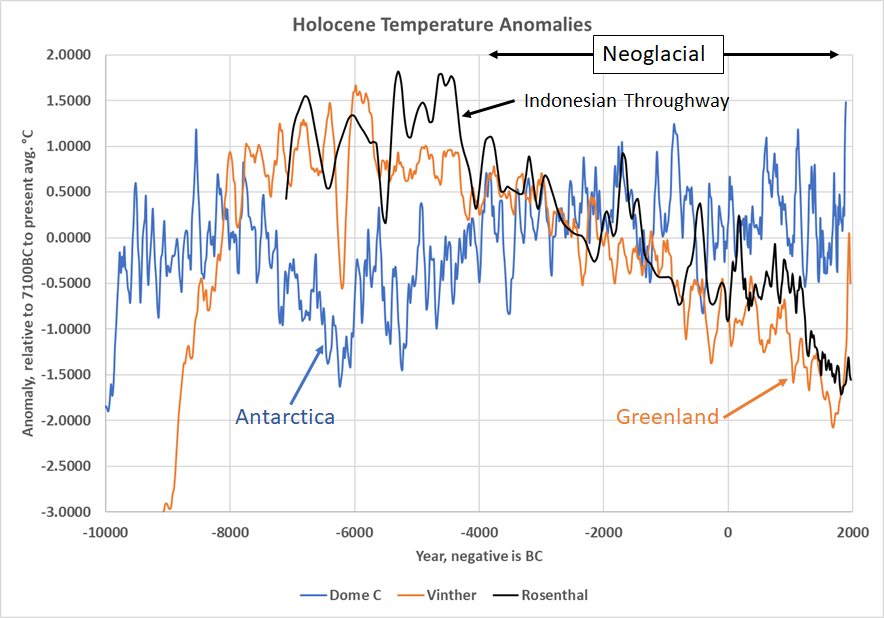By Andy May Reposted from his website
You won’t find much in the IPCC AR6 report on the atmospheric CO2 concentration evolution during the Holocene. They talk a lot about how CO2 concentration compares to global temperature during the years since 1850 and over the past 800,000 years, but very little about the changes since 12,000 years ago. On page 44 of the Technical Summary, we see the figure shown below as Figure 1.

Figure 1. The correspondence of CO2 and temperature from the AR6 Technical Summary, page 44. The Holocene portion of the CO2 record used is circled and the subject of this post
Figure 1 is designed to hide the relationship between CO2 and global atmospheric surface temperature (GAST), not illuminate it. It was designed to hide abundant, credible, and well-known evidence that through much of Earth’s history CO2 concentration goes down as global temperatures go up. Figure 2 is from Javier Vinos’ book (Vinós, 2022, p. 145). It shows the data in a much clearer and more honest way.

Figure 2. Reconstructions of Cenozoic CO2 concentration (black line) and temperature (red line). Most of the time they move in opposite directions, which is the opposite of the implied relationship shown in Figure 1 from AR6. The temperature proxy shown in red is provided in “δ18O” units, that is the fraction of oxygen 18 in the atmosphere, it is a function of atmospheric temperature. The δ18O scale is on the right. Approximate surface temperature averages (GAST) are given on the right side of the plot. Today we are near the minimum for the past 65 million years. CO2 is given in ppm (parts per million) as shown on the left scale. Source: (Vinós, 2022, p. 145)
The AR6 plot tries to imply that temperature follows CO2 concentration and uses clever temporal scaling and cherry-picked data to make that point. Figure 2 shows all the data for the Cenozoic Period using one time scale, and shows the truth is the opposite. Usually, CO2 and temperature move in opposite directions.
The circled area in Figure 1 shows the CO2 concentration increasing during the Holocene, as temperatures rise about five degrees from the last glacial maximum. This crams the entire Holocene into less than a millimeter. AR6 tells us that the “intent of [Figure 1] is to show that CO2 and temperature covary, both in the past and into the future…” But the truth of the relationship between them is cleverly hidden in Figure 1 by the design of the figure, the weird time scale, and the choice of the data used. It is not a scientific illustration meant to illuminate the truth; it is a clever bit of propaganda.
In Chapter 2 they plot Dome C and WAIS Divide CO2 from 21,000 years ago to 10,000 years ago in a very small plot (AR6, page 301). It is shown in Figure 3.

Figure 3. Antarctic ice core CO2 concentration from AR6, page 301. Both the Dome C and WAIS (West Atlantic Ice Sheet) Divide data are shown, but the plot stops at 10,000 years before today, why? Data exists beyond that
Why are they avoiding showing the CO2/temperature relationship during the Holocene Epoch? They cram it into less than a millimeter in Figure 1 and chop it off in Figure 3. The Holocene is the last 12,000 years, the proxy data quality in that period should be high, relative to the rest of the Cenozoic. Let’s look at other sources of Holocene CO2 data, like Monnin, 2004.

Figure 4. Plot of CO2 (red line), CH4 (blue line), IPCC climate model calculated temperature (green line), and proxy temperature (as Z-score, black line) for the Holocene. The CO2 record shown is from Dome C in Antarctica. The methane (CH4) record shown is from Greenland (Kobashi, Severinghaus, Brook, Barnola, & Grachev, 2007). Source: (Vinós, 2022, p. 49)
As Figure 4 shows, CO2 and CH4 (methane) atmospheric concentrations have increased for the past 5,000 to 6,000 years as global proxy temperatures dropped. This is the opposite of IPCC’s stated intent for showing Figure 1. The global proxy temperature curve shown in Figure 4 is from Marcott’s proxies but reinterpreted by Vinós (Vinós, 2022). Both the climate model temperatures and the CO2 concentrations move opposite to the proxy temperatures for most of the Holocene Epoch.
The CO2 concentration in Figure 4 is from Eric Monnin and eleven co-authors (Monnin, et al., 2004) in an article in Earth and Planetary Science Letters. Their Figure 1 is a plot of available Antarctic ice core CO2 proxies for the Holocene, it is shown as our Figure 5. In this plot the present is to the left and the beginning of the Holocene is to the right, just opposite of the previous figures.

Figure 5. Plots of CO2 from Antarctic ice core data. Squares: DML (Dronning Maud Land) data. Dots: Dome C data. Diamonds: Taylor Dome data on the new timescale by matching the CO2 records. Grey diamonds: Taylor Dome data
The Dome C ice core shows the entire Holocene. It is plotted in Figure 6, oriented like Figures 1 to 3, with the present to the right.

Figure 6. NOAA’s Dome C ice core CO2 data. Data from NOAA
In Figure 7 we compare three temperature reconstructions. We use the Vinther reconstruction for Greenland (Vinther, et al., 2009), the Rosenthal reconstruction (Rosenthal, Linsley, & Oppo, 2013) from the Indonesian Throughway in the tropical Pacific Ocean, and the Antarctic Dome C temperature reconstruction (Jouzel, et al., 2007).

Figure 7. Three temperature reconstructions from different parts of the world. The reconstructed anomalies are all relative to the respective 7100BC to present averages. Sources: Antarctica, (Jouzel, et al., 2007), Indonesian Throughway, (Rosenthal, Linsley, & Oppo, 2013), Greenland, (Vinther, et al., 2009)
Figure 7 shows that temperatures in the Northern Hemisphere decline over the past 5,000 to 6,000 years or longer, a period known as the “Neoglacial.” While Rosenthal’s reconstruction is based upon 500-meter-deep ocean temperatures in the Indonesian Throughway between Borneo and Sulawesi, the water temperatures are thought to primarily represent ocean surface temperatures in the tropical and Northern Pacific Ocean. This makes some sense as they track Vinther’s Greenland ice core temperatures fairly well.
Antarctica dances to a different drummer. It moves opposite Northern Hemisphere temperatures during the Holocene Climatic Optimum (roughly 8000BC to 4500BC) and while Northern Hemisphere temperatures drop after 4,500BC, Antarctic temperatures are flat. After 5000BC CO2 concentration increases, as shown in Figure 6.
Discussion
Renee Hannon noticed the deceptive plot shown in Figure 1 and pointed it out in the comments to my post on Javier’s interview with Tom Nelson. See her comment here. The IPCC’s stated objective is to “provide governments at all levels with scientific information that they can use to develop climate policies.” Is cherry-picking data and creating deceptive illustrations “scientific?” Is ignoring and hiding valid, peer-reviewed, relevant data “scientific?” I think not.
I’m reminded of a time I was researching an article for another publication and found that AR6 managed to discuss the famous Iris Effect (see here, Lindzen and Choi section), discovered by Richard Lindzen, Ming-Dah Chou, and Arthur Hou in 2001 (Lindzen, Chou, & Hou, 2001) and managed to do it without once mentioning any of them, check it yourself, see pages 972-973 in Chapter 7. They do mention Lindzen, et al., 2001 later in Chapter 7 in another context, so you will find the paper in the chapter bibliography. Cherry-picking, ignoring contrary data, “forgetting” to reference the discoverers of key concepts has risen to epic heights in this IPCC. I find it disgraceful.
Works Cited
Jouzel, J., Masson-Delmotte, V., Cattani, O., Dreyfus, G., Falourd, S., & Hoffmann, G. (2007). Orbital and Millennial Antarctic Climate Variability over the Past 800,000 Years. Science, 317, 793-796. doi:10.1126/science.1141038
Kobashi, T., Severinghaus, J. P., Brook, E. J., Barnola, J.-M., & Grachev, A. M. (2007). Precise timing and characterization of abrupt climate change 8200 years ago from air trapped in polar ice,. Quaternary Science Reviews, 26(9-10), 1212-1222. doi:10.1016/j.quascirev.2007.01.009
Lindzen, R., Chou, M.-D., & Hou, A. (2001, March). Does the Earth have an Adaptive Iris. Bulletin of the American Meteorological Society, 82(3). Retrieved from https://journals.ametsoc.org/view/journals/bams/82/3/1520-0477_2001_082_0417_dtehaa_2_3_co_2.xml
Monnin, E., Steig, E. J., Siegenthaler, U., Kawamura, K., Schwander, J., Stauffer, B., . . . Fischer, H. (2004). Evidence for substantial accumulation rate variability in Antarctica during the Holocene, through synchronization of CO2 in the Taylor Dome, Dome C and DML ice cores. Earth and Planetary Science Letters, 45-54. doi:10.1016/j.epsl.2004.05.007
Rosenthal, Y., Linsley, B., & Oppo, D. (2013, November 1). Pacific Ocean Heat Content During the Past 10,000 years. Science. Retrieved from http://science.sciencemag.org/content/342/6158/617
Vinós, J. (2022). Climate of the Past, Present and Future, A Scientific Debate, 2nd Edition. Madrid: Critical Science Press. Retrieved from https://www.researchgate.net/publication/363669186_Climate_of_the_Past_Present_and_Future_A_scientific_debate_2nd_ed
Vinther, B. M., Buchardt, S. L., Clausen, H. B., Dahl-Jensen, D., Johnsen, S. J., Fisher, D. A., . . . Svensson, A. M. (2009, September 17). Holocene thinning of the Greenland ice sheet. Nature, 461. Retrieved from http://users.clas.ufl.edu/rrusso/gly6932/vinther_etal_nature09.pdf
